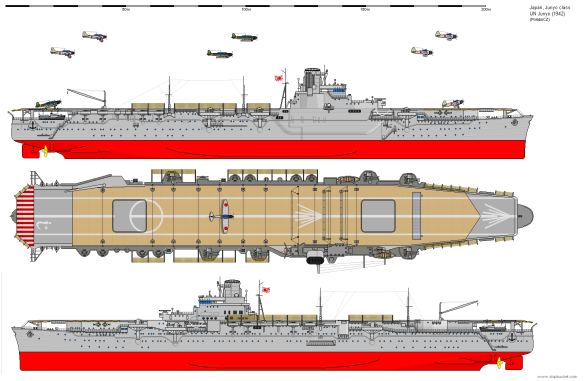As war with the United States became increasingly probable, the Imperial Japanese Navy began to convert much of this “shadow” carrier fleet. It took over the Kashiwara Maru and its sister, the Izumo Maru, in October 1941 while they still were incomplete and converted them into the fleet carriers Junyo and Hiyo respectively. Since they had been completed only to the main deck, conversion work was rapid because there was little superstructure requiring prior removal, and both vessels commissioned within eight months. As front line units their principal deficiencies were slow speed, limited internal subdivision, and the absence of armor protection, but they otherwise compared quite favorably with purpose-built Japanese carriers.
Only the larger, faster, and very much more sophisticated conversions Hiyo and Junyo fulfilled the promise of the “shadow” program.
Design: These vessels were part of Japan’s “shadow” carrier program implemented to circumvent treaty tonnage limitations. The navy funded 60 percent of their cost when they were laid down as the fast liners Izumo Maru and Kashiwara Maru for the Nippon Yusen Kaisha (Japan Mail Steamship Company). The liner design incorporated a double hull for protection against torpedoes, extensive compartmentation, additional spaces for bunker fuel and gasoline stowage and for extra electric cabling, superstructure arrangements designed for ready modification to incorporate hangars and elevators, and unique more powerful high-pressure steam power plants for higher service speed. All features were intended to ease conversion although, rather strangely, no foundations were prepared for armament installation nor was provision made to trunk furnace gases to one side to clear the flight deck. Both ships were complete to the main deck when conversion began in late 1940. The promenade deck was extended fore and aft to form the flight deck and fully equipped for aircraft operations with arresting gear, crash barriers, night landing lighting, a wind screen, and refueling points. The depth of the hull allowed construction of double hangars, each about 500 feet long, 49 feet wide, and 16 feet high, connected to the flight deck by two large elevators. These ships also featured the most elaborate bridge arrangements yet fitted to Japanese carriers and vented furnace gases through a large stack angled outboard at 26 degrees from the vertical to make sure they were clear of flight operations. Antiaircraft weapons were on side sponsons arranged just below the flight deck level. On commissioning both vessels also carried Type 21 radar sets.
Modifications: The ship’s antiaircraft batteries grew considerably as the war progressed. In spring 1943 each received four additional triple 25mm mounts and four more late in the year along with twelve single 25mm mounts. In August 1944 the Junyo added three 25mm triple mounts, two 25mm twin mounts, and eighteen 25mm single mounts, plus six 28-tube 120mm rocket launchers. The Junyo completed with its original wood-paneled passenger cabins for aircrew accommodations. These were stripped out and replaced with steel compartments in July–August 1944 and, at the same time, the spaces around the gasoline storage tanks were filled with concrete for protection.
Service: The Junyo participated in operations in the Aleutians in June 1942 and then both carriers were in action throughout the Guadalcanal campaign, although machinery problems kept the Hiyo out of the Battle of Santa Cruz. Both carriers took part in the Battle of the Philippine Sea, during which the Hiyo was sunk by aircraft from the Belleau Wood and the Junyo seriously damaged. The submarines Redfish and Sea Devil hit the Junyo with two torpedoes on December 9, 1944. It reached Sasebo under its own power and was repaired by March 1945 but never reentered service. It was stripped of its armament between May and August 1945, stricken from the navy list on November 30, and scrapped between June and August 1946.
Junyo
Builder: Mitsubishi Shipbuilding Company, Nagasaki
Laid down: March 20, 1939.
Launched: June 26, 1941. Commissioned: May 5, 1942
Displacement: 24,140 tons (standard), 29,464 tons (full load)
Dimensions: 719’6” (oa) x 87’7” x 26’9” (mean)
Flight deck: 689’0” x 89’6”
Machinery: Geared turbines, 6 Kampon boilers, 2 shafts, 56,250 shp = 25.5 knots
Bunkerage & range: 3,000 tons
Aircraft: 53
Armament: 6 x twin 5” AA, 8 x triple 25mm AA
Complement: 1,200
